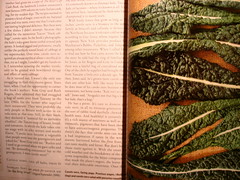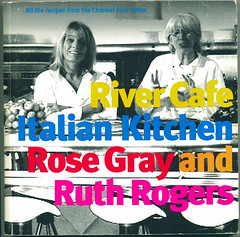Cavolo Nero!
The first thing you should know about cavolo nero is that, contrary to what its name might lead you to believe (cavolo = cabbage, nero = black), it's not actually black, it's just very, very green.
 fig. a: cavolo nero waiting to be rinsed
fig. a: cavolo nero waiting to be rinsed
The second thing you should know is that while it might appear to be just another odd, almost whimsical, late-harvest green, it's remarkably nuanced, remarkably supple, one of the finest greens that we've ever encountered (and we like our greens!), and one that we felt we had a deep connection with from the first time we tasted it. And I'm not talking about "love at first bite" here--I'm talking something more uncanny.
Anyway, the third thing you should know is that if you live in Montreal, cavolo nero, this most prized of Tuscan greens, is readily available at the moment, albeit for a limited time only. (It's very hearty, growing long into the winter in Italy, but it's not winter-in-Montreal hearty.)
Now, I must confess, we were totally unfamiliar with cavolo nero until about 10 days ago. At the time, my sister was visiting from out of town, and on one particularly nice afternoon, we made our way to Jean-Talon Market to pick up all the necessities for a ham feast we had planned. I was in the mood for kale or chard or some other kind of hearty green, and my sister agreed that sautéed greens might just do the trick, so we made our way to Birri to see what they had in stock. I noticed a type of kale that I'd never seen before--it was attractive and it looked like it had potential, so we bought a bunch and brought it home. It was only when I got home and started flipping through our November issue of Saveur (which had just arrived a day or so earlier) that I found out what I'd just bought, because right there, beginning on page 78, was an entire article on cavolo nero.
 fig. b: cavolo nero by Saveur
fig. b: cavolo nero by Saveur
Saveur's cavolo nero spread was definitely striking, catching my eye immediately, but when someone goes so far as to refer to an item you just happened upon at the market as "autumn's tastiest vegetable" you pay extra-close attention.
Since that fateful day we've been busy getting to know cavolo nero, and, as I suggested above, we've quickly developed a profound respect for this wonderful fall and winter green. Aside from braising them then gently sautéeing them with olive oil and garlic, we've made two recipes with cavolo nero in the last 10 days, both of which appear in the Saveur article, both of which were adapted by the folks at Saveur from recipes in Rose Gray and Ruth Rogers' landmark River Café Italian Kitchen cookbook, and both of which, tragically, had somehow been overlooked by Michelle and I each of the previous times we'd leafed through our personal copy of the River Cafe cookbook.
 fig. c: slightly tattered AEB copy of River Cafe Italian Kitchen
fig. c: slightly tattered AEB copy of River Cafe Italian Kitchen
The first of these recipes is a classic Tuscan bean soup that's 100% vegetarian and no less flavorful for it. It's based loosely on a recipe for Summer Ribollita that appeared in the River Cafe cookbook.
Ribollita
1/4 cup olive oil
1/2 cup flat-leaf parsley leaves, chopped
6 celery ribs, chopped
4 garlic cloves, chopped
3 carrots, chopped
1 red onion, chopped
salt and freshly ground black pepper to taste
1 28-oz can whole peeled tomatoes
2 lbs cavolo nero, trimmed and roughly chopped
3 14-oz cans borlotti beans [we used romano beans instead], drained
1 stale ciabatta loaf, crust removed
3 tbsp extra-virgin olive oil + a bit more for drizzling
freshly grated parmigiano-reggiano
Heat the 1/4 cup of olive oil in a large pot over medium-high heat. Add the parsley, celery, garlic, carrots, onion, and the salt and pepper. Cook, stirring occasionally, until onions are translucent and have in fact begun to brown ever so slightly, about 10-15 minutes.
Crush the contents of the can of tomatoes and add to the pot. Reduce the heat to medium-low, and cook until the liquid has been reduced to next to nothing and the vegetables have taken on a rich flavor, about 20-30 minutes. Add the cavolo nero, 2 of the drained cans of borlotti [or romano] beans, and 1 gallon of water. Cover, bring to a boil, then reduce the heat and simmer uncovered until the cavolo nero is tender, about 30 minutes.
Meanwhile, add the last can of drained borlotti [or romano] beans with 1/2 cup of water to a food processor or blender and purée them. When the cavolo nero is tender, add this mixture to the pot. Tear the ciabatta loaf into 1" pieces, and add them to the pot with 3 tbsp extra-virgin olive oil and salt and pepper to taste. Cook, stirring, until thick, about 30 minutes. Serve drizzled with extra-virgin olive oil and topped with a bit of parmigiano-reggiano.
Makes enough to serve the whole Italian army.
[AEB variation: good quality ciabatta loaves being something of a rarity here in Montreal, we replaced the stale ciabatta loaf with half a stale baguette, which we toasted into croutons (by sautéeing them lightly in olive oil until golden) and used to garnish each bowl (along with the extra-virgin olive oil and the parmigiano-reggiano). Delicious.]
[adapted from a recipe in the November 2007 issue of Saveur]
The second recipe is a much simpler one, but it's also the more astounding of the two, showing off cavolo nero's remarkable versatility. Here, cavolo nero is used to make a pesto, and its herbal qualities fill in for the basil you'd find in a classic pesto Genovese, while its natural nut flavors fill in for the pinenuts. Hard to believe, I know, but it works, and it makes for one of the best pestos either of us has ever had or made.
Cavolo Nero Pesto
1 large bunch cavolo nero leaves, stems removed
salt and freshly ground black pepper to taste
4 garlic cloves peeled
1/2 cup extra-virgin olive oil
1 1/2 cups grated parmigiano-reggiano
Bring a pot of salted water to a boil. Add the cavolo nero and 2 cloves of garlic. Cook until bright green, about 3-4 minutes. Drain and transfer both the cavolo nero and the garlic to a food processor. Pulse into a rough purée. Pour in 1/4 cup of the olive oil and pulse into a pesto. Crush the remaining two garlic cloves with 1 tsp sea salt in a mortar. Add to the food processor, along with the remaining 1/4 cup of olive oil and the parmigiano-reggiano. Pulse again one or two more times. Adjust seasoning.
Use as you would use a pesto Genovese: with pasta, with tomatoes and mozzarella, etc.
[adapted from a recipe in Rose Gray and Ruth Rogers' River Cafe Italian Kitchen]
aj









9 comments:
This is a wonderfully informative post. This is the third time just today that I've read about this kale. I have great farmers markets here in the DC area and am going to be picking up a bunch this weekend.
Thanks!
Hi Ramona,
Assuming its available, cavolo nero should have a considerably longer season down in the DC area. Just out of curiosity--which farmers' markets do you go to down there? I'm kicking myself over the fact that I just found out Calhoun hams are available at the Alexandria farmers' market. If only I'd known that back in August when we were down that way. God knows how we would have gotten that ham back, but we would have tried.
this stuff's been a favourite of mine since my semester in italy, circa 1999; it's so good! and i pretty much lived on ribollita for those few months. your recipe is making me crave it again...
i feel like it actually comes and goes throughout the year here in montreal. sometimes birri will have it, sometimes nino, sometimes that organic stand whose name i forget, etc. you just have to grab it when you see it, i guess.
hey A-M,
it's called Black Kale here, and we are going to try making this on Sunday. Actually D is going to. Wish us luck! also ate a meyer lemon tonight and thought of Michelle. ate it whole, it ruled.
xosyd
hi molly,
a semester in Italy with lots of ribollita?-I'm jealous--the thing about Birri is that they grow it themselves--I'm not sure where some of the other cavolo nero comes from--I don't know how much of it is local--thanks for writing
hi sydney,
how did it turn out?--guess I'm going to have to check your blog to find out--meyer lemons do rule, you're right--i'm glad Dan made it back safe & sound--wish we'd been there to partake in the cavolo nero madness
Thank you for the pesto recipe! I finally got round to getting some parmesan cheese & making a batch of it. They are growing cavolo nero in the UK now (where I am based), so there will hopefully be more experimentation at this end, too! I have made two soups so far and your extremely tasty pesto! :)
you're welcome, Something,
glad you liked it--it's really one of my faves
and thanks for the shout out too
aj
This is a wonderful post. I know this post is older, but wondered if you ever heard of cavolo nero being used to make a starter for something like an Italian Pizza Bianca? Seems like someone did that in Italy years ago.
Hi, LPM,
no, I haven't heard of that--I've only heard of it as a topping--the cavolo nero pesto would be particularly good on a pie
thanks for writing
Post a Comment